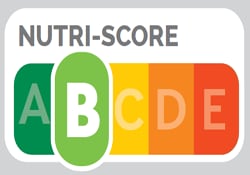Belgian public health minister Maggie De Block said that the new labelling system will make it easier for consumers to eat balanced diets. “We are facilitating the choice of healthy eating,” she said as the launched the initiative.
The decision to back the NutriScore labelling system comes after what the Ministry of Health described as “extensive consultation” with stakeholders including consumer organisations as well as food and retail representatives.

NutriScore ranks foods from -15 for the 'healthiest' products to +40 for those that are 'less healthy'. On the basis of this score, the product receives a letter with a corresponding colour code: from dark green (A) to dark red (F).
The algorithm on which the score is calculated takes into account both positive and negative elements. The content of sugars, saturated fatty acids, salt and calories have a negative influence on the score, while the presence of fruits, vegetables, fibre or protein have a positive impact.
NutriScore the 'preferred choice'
Minister De Block said that the NutriScore system was the preferred choice over other labelling systems, such as the UK’s traffic light scheme, because tests in France – where it has already been adopted – show it has “greater impact” on buying behaviours than other systems.
Indeed, this was recently confirmed by French retailer E.Leclerc in survey of 300,000-consumers, which showed NutriScore is best in encouraging healthy food choices, especially among younger shoppers and those from lower socio-economic backgrounds.
Unlike traffic light labels, which break out individual components such as salt and fat content, NutriScore provides a single score for the entire product. This gives consumers an “overall assessment of the product at a glance”, the Health Ministry concluded.
The minister also said that the introduction of the scheme has secured the support of stakeholders. “A label will only have the desired effect if all stakeholders are involved.”
NutriScore welcomed by stakeholders?
Industry support is necessary because the scheme will remain voluntary, the Ministry of Health noted. “No producer or distributor of food will be obliged to use it,” De Block stressed.
Ahold Delhaize had already committed to rolling out NutriScore across its private label lines in Belgium Delhaize stores over the next two years. In June the company said it would “take the lead” by introducing the nutritional labelling scheme as part of its drive to reposition itself in the market by focusing on the message “better eating is at the heart of better living".
Retailer Colruyt has also signalled its support. The company will begin to introduce the labelling scheme this this autumn, starting with around ten products.
Retailers are credited with having made the UK’s traffic light logo widespread in Britain. In 2012, the government struck a voluntary deal with the country’s major supermarkets that led to the logo, developed by the Food Standard’s Agency, becoming widespread.
Belgian consumer organisation Test Aankoop welcomed the move, which it has been pushing for as part of its campaign to support healthy eating.
“Test Aankoop will continue its fight against unhealthy food through its research and communication but is nevertheless pleased that an important step was taken today with the introduction of a NutriScore system,” the consumer watchdog said in a statement.
“The consumer organisation will review its application conditions and continue to work towards the roll-out of the system over the entire market in optimal conditions and in the interest of the consumer.”
The reaction of food manufacturers to NutriScore has typically been more muted. Since the logo was officially launched in France in October last year, a few manufacturers have begun to add it to their products - such as Fleury Michon and Danone Fresh – but uptake has not been widespread.
Belgian food industry group Fevia (La Fédération de l'industrie Alimentaire Belge) expressed concern that the system was an "over simplification" of nutritional guidance. Speaking to FoodNavigator, spokesman Nicholas Courant said that NutriScore failed to distinguish between the divergent nutritional requirements of different consumer groups. "The nutritional needs of a 25-year-old athlete are completely different from those of a 75-year-old woman," he noted.
Courant suggested that a more useful approach could be to utilise technology by, for instance, developing apps that provide consumers with more detailed recommendations. However, he stressed: "We share the objectives [of the Government] which are to help people eat healthier foods."

